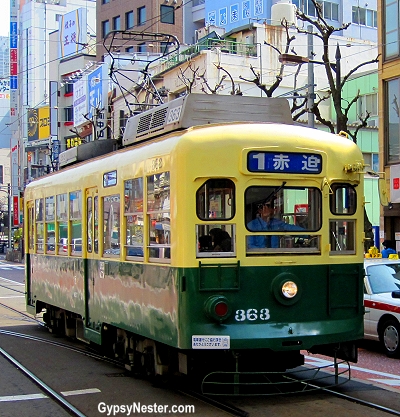
Right up until we stepped off the ship in Nagasaki, Japan, our feelings about visiting the site of the second atomic bomb attack were conflicted.
But the city has a quiet, peaceful atmosphere that put us at ease.
In spite of any misgivings we may have had, we knew that our primary destination was the area around the bombing.
The bomb missed its intended target by nearly two miles, sparing the center of town from destruction, so we hopped on the number one trolley and rode to the north end of town where the blast occurred.
Peaceful Reflection
Spring was in full bloom, so the path up the hill to The Peace Garden was brilliantly lined with flowers and the cherry blossoms were reaching their peak.
A remarkable sight anywhere, but made even more remarkable since many scientists predicted that no vegetation would grow on this ground for seventy-five years because of the radioactive fallout.
See more about the significance of the cherry blossoms in Japan
The garden is dedicated to peace, and the hope that an atomic weapon will never again be used against the people of the world. It was also an excellent spot to begin our visit to all of the memorials.
From here we could easily walk to the Urakami Cathedral, the epicenter, and the Atomic Bomb Museum before looping back to the tram at its next stop to the south.
Monuments, given from cities and countries all around the globe to demonstrate their commitment to world peace, line the walkways that lead to The Fountain of Peace.
The fountain’s spraying water forms dove’s wings as a symbol of peace. Water has an emotional attachment to this memorial because so many died due to the lack of any drinkable water.
This was most poignantly brought to our attention by the inscription on the fountain. Sachiko Yamaguchi, a girl only nine years old at time of the bombing, wrote “I was thirsty beyond endurance.
There was something oily on the surface of the water, but I wanted water so badly that I drank it just as it was.”
See more about The Peace Garden here
Opposite the fountain, the park is dominated by a huge statue known as The Prayer Monument for Peace. Towering thirty feet high, it was erected on August 9, 1955, the tenth anniversary of the explosion.
The mammoth figure has his right hand extended upwards toward where the bomb fell, and his left outstretched in a gesture of peace. His eyes are closed in prayer.
It’s hard to say how long we spent taking in the garden because there is a timeless, almost dreamlike quality to the memorial. After some time we still had difficulty sorting our emotions out.
One thing we can say for certain, the park was incredibly successful at conveying its message of peace.
See more about The Peace Garden here
Surviving Saints
Looking down from the garden we could see Urakami Cathedral a few blocks away. This was once the largest Catholic church in The Far East, but stood just a few hundred feet from the center of the blast.
However, a handful of statues survived the devastation and are now displayed in front of the rebuilt church.
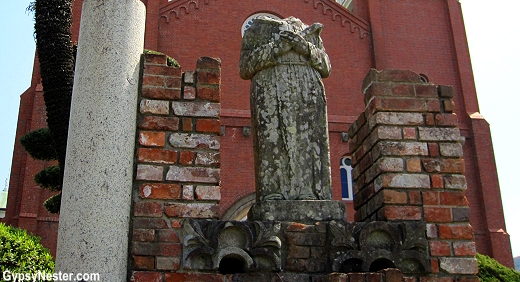
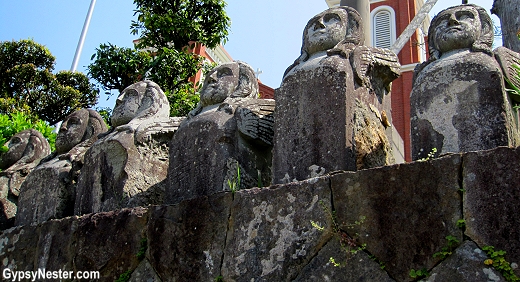
See more of these eerie statues that survived the bomb at Urakami Cathedral
Before the rebuilding, one small section of an original wall that remained standing was moved and placed on display at ground zero.
So we walked along the Shimonokawa River down to the hypocenter, the point directly below the explosion which was exposed to the center of the bomb’s destructive force, to see.
The Hypocenter
The precise point is marked by a cenotaph, an empty tomb to honor those never found, in the center of concentric circles.
The Urakami Cathedral wall stands just off to the side. Just below the wall remnants, along the river, a window is cut into the bank.
We peered in and saw the ground as it was just after the explosion, strewn with crushed brick, scorched rock and melted glass.
See more photos of the memorial at the hypocenter
But again, despite the horrific history of this spot, our feelings were directed toward peace and remembrance. The site is incredibly solemn, yet very beautiful.
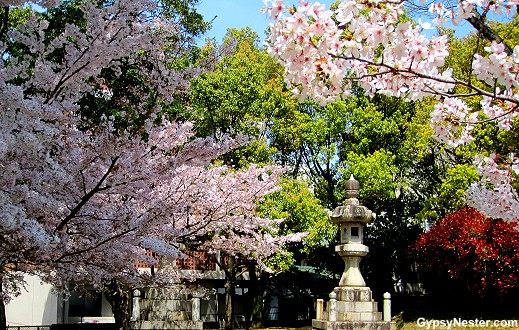
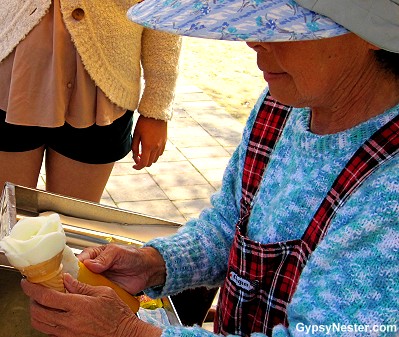 Want to see how she does it? Click for the video here
Want to see how she does it? Click for the video here
On our way out we came upon an elderly lady creating wonderful rose blossoms out of what we thought was ice cream. It turned out to be a subtle flavored ice made with rosewater.
See more photos of the memorial at the hypocenter
We sat and enjoyed our cones for a few minutes before heading up to what we knew would be an emotionally draining visit to The Atomic Bomb Museum.
The Clocks Forever Stopped at 11:02
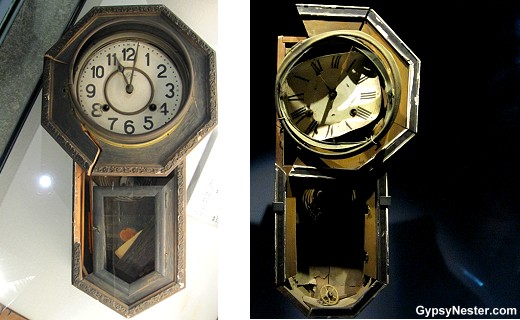
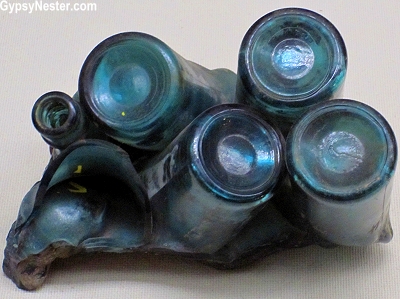
The museum details Nagasaki before, during, and after the blast, as well as the history of the development and deployment of the bomb. We entered into a room depicting life in the city just before the attack.
It was a normal morning, and there was no warning whatsoever, no air raid sirens sounded, and no one made it into any of the numerous shelters.
We continued into a darkened room showing the aftermath of the explosion. As our eyes adjusted we began to see the items clearly, a twisted water tower, a replica of the collapsed cathedral, and photographs of the destruction.
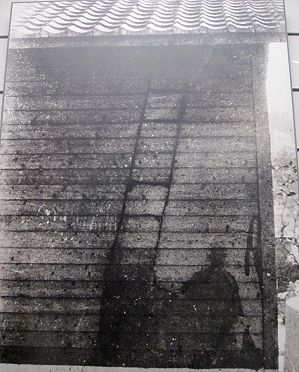
Our attention was captured; it was almost like walking back in time through the ruins. We found it hard to breathe normally.
The main hall of the museum contained artifacts left from the devastation, stopped clocks, melted glass, charred human bone. Striking first-hand accounts from survivors.
An eerie photo entitled Silhouette of a Lookout and his Ladder Remain on a Wall was taken about three miles from the hypocenter after tar exposed directly to the flash of the bomb burned.
The tar disappeared, but the shadows remained on the Nagasaki Fortress Headquarters.
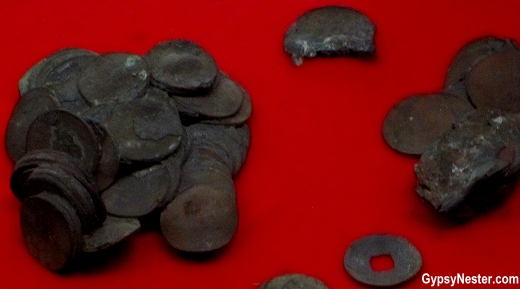
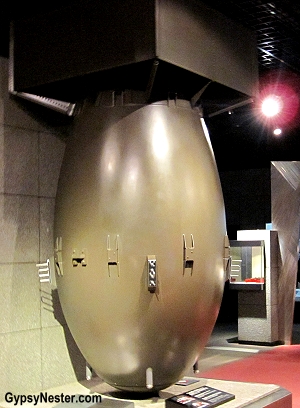
A good deal of attention is given to the development of atomic weapons.
Displays cover the entire process, including a full size model of “Fat Man” as the bomb was known.
Numerous statements from scientists warn of the consequences of nuclear weapons, but the museum offers no opinions on the politics or reasons for the war, only facts about the bombing.
After considering it all, this struck us as a powerful method to convey the message of hope that these weapons are never used again.
Steamed Buns in Chinatown
Our minds were certainly filled with plenty to think about, but by this time our bellies were pretty empty. We also felt we should lighten the mood a bit, so we grabbed a trolley back down to the old part of town to seek some grub in Japan’s oldest Chinatown.
Nagasaki’s four hundred year old Shinchi Chinatown holds that distinction because this was Japan‘s only port open to Chinese trade during the era of isolation, when the country restricted any contact with the outside world. Today it has become the center of the city’s food culture.
The first thing we encountered was kakuni-manju. These sandwiches of braised pork cutlet in a steamed bun were being sold everywhere. It seemed like every storefront had a counter, and every corner a cart offering these delicacies. They smelled great and tasted every bit as good. Sure we were hungry, but this might be the best street food ever!
After two or three, we figured we’d better stop and save some room, because we couldn’t possibly visit Japan without trying the sushi. We found a small place tucked in between all of the Chinese restaurants and kakuni-manju stands and ordered the chef’s choice plate.
We were mostly curious to see if the sushi we were used to getting back in The States was authentic. It looked the same, but the taste wasn’t even in the ballpark – this was the freshest, yummiest, melt-in-your-mouth stuff ever. We were so excited that we sampled the salmon before we thought to take a photo.
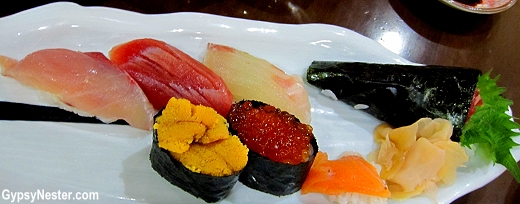
Eyeing the Spectacle Bridge, a more pleasant reflection
A few blocks from Chinatown is one of Japan’s most famous bridges dating back to 1634. So after our raw fish we walked along The Nakajima River, passing several of the ten old stone bridges that span the river, until we saw our destination.
With our first look it was clear why this is better known as The Spectacle Bridge than its real name, Meganebashi. The reflection in the water really does look like a pair of eyeglasses.

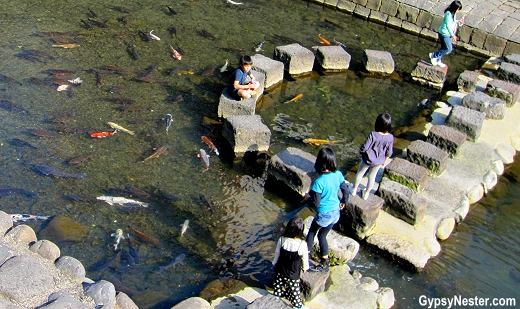
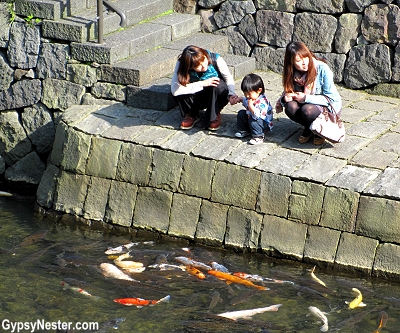
We didn’t need our glasses to see that it was getting late in the day and we needed to hustle back to the ship.
Once again Nagasaki’s cheap, convenient, and easy to use trolley system came in handy.
A Spectacular Send-off
This quiet, peaceful city had one last surprise in store for us, as we got back on board we were given a rousing send off with a Chinese dragon dance, complete with traditional instruments and firecrackers.
WATCH: Beautiful Dragon Dance
David & Veronica, GypsyNester.com
Delve Deeper:
The Peace Garden
The Statues of the Urakami Cathedral
The Atomic Bomb Hypocenter
Cherry Blossoms in Japan
Video – How to make a rosewater ice bloom
Click here for our full live-blog as we traveled with Holland America aboard the ms Volendam – through Hong Kong, China, South Korea and Japan


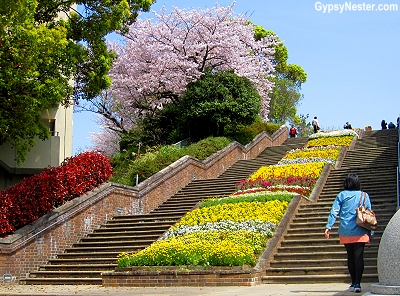

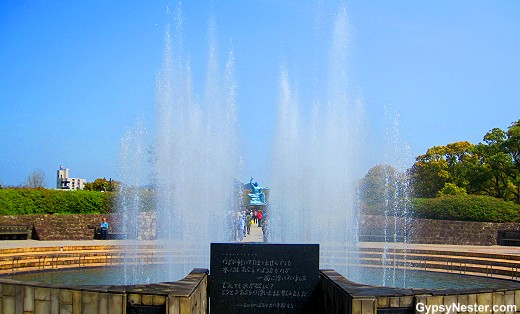
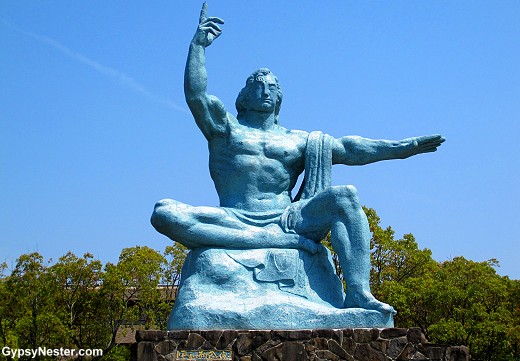
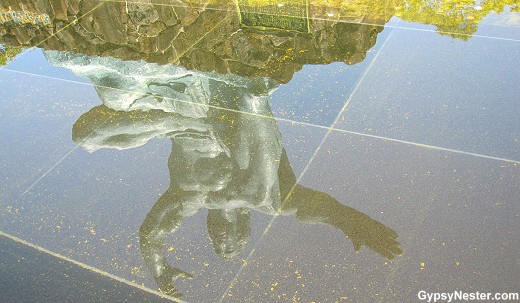

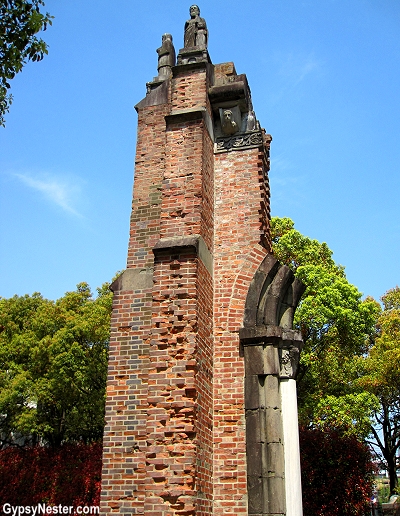
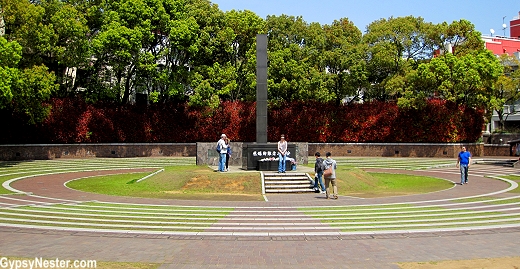
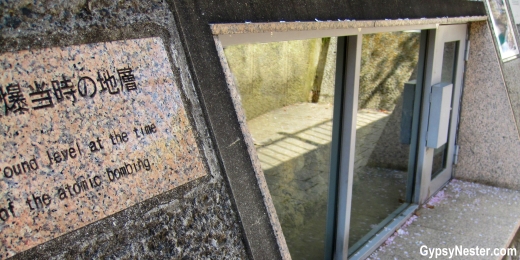
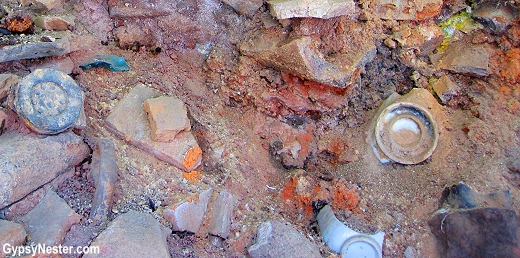
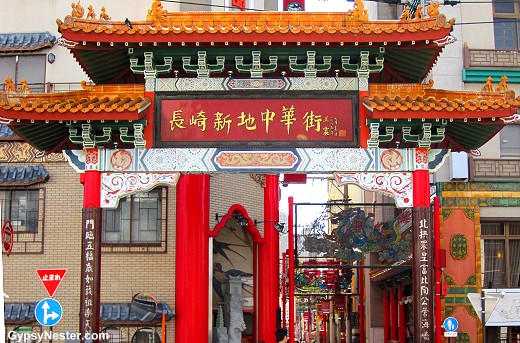
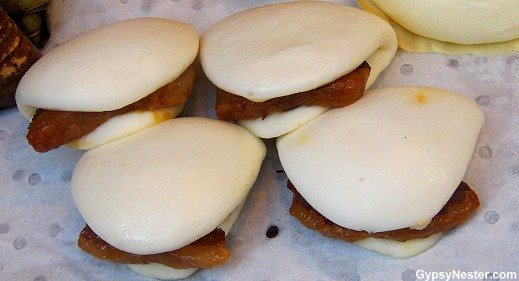
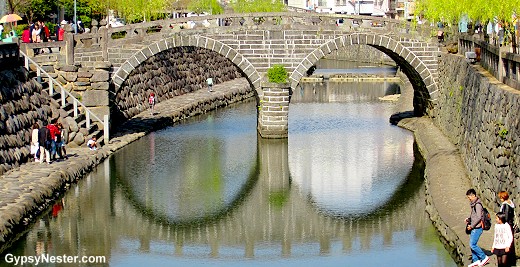
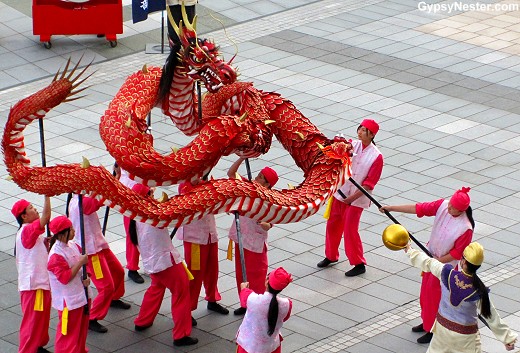
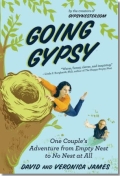
Interesting the same exact kind of damage is seen all over egypt’s ancient ruins… Hmmm…….
This is really interesting, You’re a very skilled blogger.
I’ve joined your feed and look forward to seeking more of your wonderful
post. Also, I’ve shared your site in my social networks!
Thanks!
I have wanted to write about something similar to this on my web page and you gave me a good idea.
Cheers.
The feeling of calm and serenity is familiar to me from my recent visit to Hiroshima. They have a similar park with monuments and a similar museum as well. They also manage to create a feeling of peace while educating about war.
We found it to be a very impressive approach to a horrible subject.
I visited Nagasaki on my first trip to Japan, and found it to be emotionally draining. However, to see the resilience of the city and the Japanese people is heartwarming. I would love to go back to Nagasaki and spend a few days exploring.
Overall we felt uplifted too. Sad, but encouraged.
We have been to Japan but never to Nagasaki. Like all war memorials I am sure it is difficult to understand how wars can happen when you are there contemplating the tragedy many years later.
Dear Gypsy Nester–
What a fantastic blog! I’ve enjoyed exploring it.
I’m writing to you now to inquire as to whether you would consider allowing me to reproduce–with attribution, of course–your terrific image of the Nagasaki Peace statue (the first one posted above). To explain: I’m a literature scholar, and have an essay on Kazuo Ishiguro’s “Japan novels” coming out in a collection published by McGill-Queens University Press next year. The essay would be strengthened by a photograph like yours. If you’re interested or curious, I’d be happy to provide more details via email. Many thanks for considering!
Thanks Claire, we will contact you by email about the photo.
actually megane means glasses, and bashi means bridge
Thanks!
The movie, “All That Remains” will be released this summer. It is the story of Dr. Takashi Nagai, a Japanese radiologist, Japanese Christian, and survivor of the Nagasaki bomb. He is often credited for his spiritual leadership which helped the people of Nagasaki recover from the bomb. It’s quite a story. You can read the story before the movie comes out, in the book, A Song for Nagasaki (http://www.goodreads.com/book/show/6552272-a-song-for-nagasaki), and you can see an early movie trailer here: https://www.youtube.com/watch?v=ZANSG-WW200
Thanks for the info Bill, this looks very interesting.
I loved our visit to Japan during Cherry Blossom season. We didn’t make it to Nagasaki but did visit the tallest Buddha Statue in Japan near Aomori. It was a monument to all the fallen soldiers.
This is a great post. The Peace Garden seems to be very well done, and from what you write, hasn’t devolved into some sort of tacky showground. The way you describe it makes it sound beautiful.
On a lighter note, those pork cutlet steamed bun sandwiches…ohmygod. I want one SO BADLY.
The gardens and the museum were both extremely well done. Somber and respectful. And yes, the steamed buns were awesome.
I’ve always wanted to see the cherry blossoms.
But indeed, a very solemn experience….and a reminder of just how horrific humans can be when pushed to the brink, all in the name of “civilization.
Much better to just live in peace and harmony.
Thanks for sharing!
Agreed! Thanks.
It’s definitely difficult to visit sites like these. It is interesting how you felt peace and calm at the memorial.
They made a choice to focus on peace going forward as opposed to the horrific event of the past. It worked really well.
The statue photos are amazing. Also a groovy dragon send-off at the end!
Thanks!
What a solemn experience. I have thought about wanting to visit a similarly solemn place, one of the concentration camps in Europe. On one hand, I know that they are really important sites to understand, but I also know that it will not be an easy place to visit.
I am continually amazed as we have traveled around the world how many places were affected by the chaos of WWII (I guess that is why they call it a world war). We are lucky that it is hard to imagine the horrors of that time happening in our modern world.
It’s true these places are hard to visit but hopefully by preserving them we will learn to avoid the same mistakes again.
Peace monuments are tricky because they seem to exist because of the atrocity of war. We visited the Memorial de Caen in Normandy in France. It is a museum dedicated to peace, but it documents the atrocities of the 20th century in Europe, including the leveling of Caen in order to liberate it. We were near Hiroshima in Japan, but didn’t go. Ever since I had my own children, I find the suffering of civilians to prompt some type of time travel PTSD in me.
It is certainly hard to come to grips with but this seemed very well done.